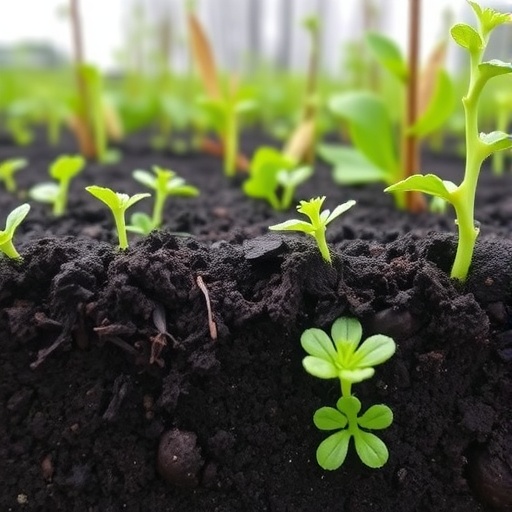In an era marked by escalating environmental challenges, the persistence of organic pollutants in ecosystems poses a formidable threat to public health and environmental sustainability. Researchers from the Chinese Academy of Sciences and the University of Chinese Academy of Sciences have brought forward a pioneering approach that harnesses the synergistic capabilities of biochar and microbial communities to degrade these hazardous contaminants effectively. This innovative strategy marks a significant milestone in environmental remediation and promises to transform how we confront persistent organic pollutants (POPs).
Persistent organic pollutants, including polycyclic aromatic hydrocarbons, chlorinated solvents, and various pesticides, are compounds characterized by their long-lasting stability in the environment and their potential to bioaccumulate in food chains. Their chemical resilience renders conventional remediation technologies — such as chemical oxidation, thermal treatment, or soil excavation — costly, environmentally invasive, and frequently ineffective. Amid these challenges, bioremediation, leveraging microorganisms to detoxify pollutants, has emerged as an attractive alternative due to its eco-friendly nature. However, microbial efficacy in heavily contaminated sites is frequently compromised by toxic conditions, nutrient scarcity, or environmental stresses.
The newly proposed framework centers on the use of biochar, a carbonaceous material produced by pyrolysis of organic biomass under limited oxygen conditions. Biochar’s unique physicochemical properties, including high porosity, large specific surface area, and diverse surface functional groups, create a multifaceted platform for adsorbing pollutants and supporting microbial colonization. By serving as a scaffold for microbial adhesion and growth, biochar not only protects degrading microbes from toxic environmental factors but also concentrates contaminants in proximity to their biocatalysts, thereby enhancing biodegradation kinetics.
Several recent advancements have amplified the potential of biochar-supported microbial systems. Enriching biochar with nutrients and electron donors tailored to microbial metabolic needs optimizes microbial vitality and activity within polluted matrices. Moreover, biochar can be engineered with specific surface chemistries to selectively adsorb target pollutants, ensuring enhanced contaminant bioavailability for microbial degradation. Complementing these advances, the design of synthetic microbial consortia—assemblies of different microorganisms with complementary degradative functions—facilitates comprehensive breakdown pathways for complex pollutant mixtures.
Practical applications of biochar-supported microbial remediation have demonstrated remarkable successes across diverse contaminated domains. In agricultural settings, they have accelerated the decomposition of persistent pesticide residues, restoring soil health and crop safety. In industrial wastewater treatment, these systems have facilitated rapid detoxification of polycyclic aromatic hydrocarbons and dye contaminants, transforming effluents into less harmful discharges. Domestic environments, often plagued by mixed organic pollutants, have also benefited from these integrated approaches, which advance pollutant mineralization without generating secondary waste.
While the laboratory and pilot-scale achievements are promising, translating these biochar-microbial systems to field-scale deployment demands rigorous validation and monitoring. Long-term studies evaluating microbe survival, pollutant degradation rates, and ecosystem impacts are essential for optimizing system design and operational conditions. Additionally, understanding the interactions among biochar properties, microbial community dynamics, and environmental variables is crucial for tailoring interventions to specific contamination profiles and site conditions.
Beyond immediate remediation outcomes, biochar-supported microbial technologies align with the principles of circular economy and sustainable development. By repurposing biomass waste into functional biochar and harnessing natural microbial processes, these systems minimize reliance on chemical reagents, reduce environmental footprints, and promote ecosystem restoration. Such interdisciplinary convergence of materials science and microbial ecology epitomizes the future of environmentally responsible innovations.
Lead author Haowei Wu emphasizes the transformative potential of this approach, highlighting how the integration of advanced biochar materials with engineered microbial ecosystems can revolutionize pollution management. According to Wu, “This strategy offers new hope for restoring polluted environments and safeguarding public health by enabling effective and sustainable degradation of recalcitrant organic pollutants.”
The scholarly article detailing these findings is published in the latest issue of Biochar, a peer-reviewed journal dedicated solely to biochar research across disciplines such as environmental science, agronomy, and materials engineering. The open-access publication invites researchers worldwide to explore the intricate science underpinning biochar applications and their environmental implications.
Biochar as a material stands at the interface of multiple scientific domains. Its production parameters—including feedstock type, pyrolysis temperature, and post-treatment modifications—profoundly influence its physicochemical nature and, consequently, its interaction with both pollutants and microbial communities. Thus, interdisciplinary research efforts are vital for forging next-generation biochar products optimized for site-specific remediation tasks.
Moreover, dissecting microbial community structures within biochar matrices elucidates the biological mechanisms driving degradation pathways. Molecular techniques such as metagenomics, transcriptomics, and proteomics afford insights into the functional genes engaged during pollutant breakdown, offering opportunities to engineer bespoke microbial consortia with enhanced catabolic capabilities.
Environmental remediation strategies integrating biochar-supported microbial systems directly address sustainable management goals by emphasizing in situ treatment modalities. Unlike mechanical removal or incineration, such biological-chemical hybrid systems maintain soil integrity, conserve resources, and mitigate secondary pollution hazards, thereby aligning remediation with ecosystem preservation.
Importantly, future research trajectories should focus on scalable production methods for functionalized biochar, deploying synthetic microbial communities resilient to complex environmental stresses, and integrating real-time monitoring technologies to track degradation progress. Collectively, these advancements will catalyze the transition from laboratory feasibility to widespread environmental application.
In conclusion, the innovative use of biochar-supported microbial systems represents a paradigm shift in combatting persistent organic pollutants, combining the strengths of material science and microbial ecology into a potent system for environmental remediation. As the global community grapples with mounting pollution challenges, such forward-thinking strategies illuminate pathways towards healthier ecosystems and a more sustainable future.
Article Title: Biochar-supported microbial systems: a strategy for remediation of persistent organic pollutants
News Publication Date: 26-Sep-2025
References: Wu, H., Huo, Y., Qi, F. et al. Biochar-supported microbial systems: a strategy for remediation of persistent organic pollutants. Biochar 7, 113 (2025). DOI: 10.1007/s42773-025-00506-7
Image Credits: Haowei Wu, Yuxin Huo, Fengyuan Qi, Yuqi Zhang, Ran Li & Min Qiao
Keywords: Bioremediation, Environmental remediation, Biotechnology, Environmental engineering, Environmental sciences




